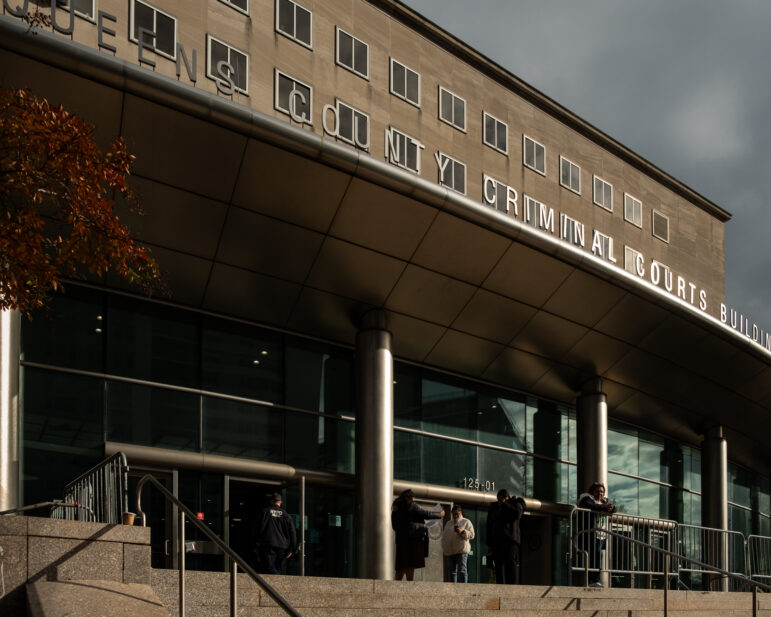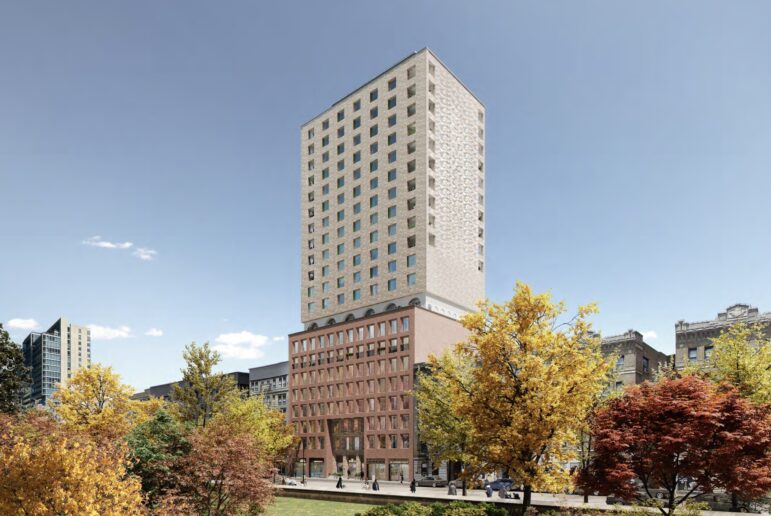Jean Delphonse, owner of Café One on the corner of 140th Street and Amsterdam Avenue, sat in the spiffy coffee shop he’s run independently since 2004, his eyes full of pride as his customers sipped freshly brewed coffee and munched on chocolate danishes. A self-determining soul who enjoys being his own boss, Delphonse is always looking for ways to improve his business.
That’s why he’s an enthusiastic participant in the Heritage Heights Village Initiative, a project to “enhance” the quiet commercial strip on Amsterdam between 140th and 145th Streets in Harlem. Storefronts will get stylistically similar signs and awnings, vacant shops will be filled, the melodies of old-time Harlem jazz will spill from cafes onto evening sidewalks, and tour buses will unload visitors with money to spend. That’s the vision of this homegrown effort. But amid changes rocking the broader neighborhood, such endeavors trouble some Harlemites – giving them pause and making them wonder aloud about the proper balance between progress and preservation.
“It is what it is. Some businesses will come, some businesses will go,” says Delphonse, a former Harlem resident who now commutes from New Jersey. He’s not fundamentally worried that the neighborhood’s character might be lost. “These changes, the way I see them, they’re inevitable.”
If this café owner’s entrepreneurial spirit carries an echo of founding father Alexander Hamilton, perhaps that’s because, as Heritage Heights Village concept founder John Cardwell says, Hamilton’s spirit is the driving force behind this project. A New York Landmarks sign on 143rd Street commemorates the onetime local resident and Secretary of the Treasury after whom Hamilton Heights is named. Cardwell adds that he sees the Heritage Heights Village Initiative’s work as paying homage to the architect of America’s economy by becoming “a positive demonstration of how capitalism can work” for the betterment of Harlem.
The plan to revitalize the area was begun more than a decade ago by an organization now called Heritage Health and Housing, a nonprofit development agency focused primarily on rehabilitating “special needs” New Yorkers such as the previously incarcerated or the mentally ill. After HHH renovated the landmark Hudson Hotel at 1649 Amsterdam and turned it into a rehabilitative residence, the group felt it could also rehabilitate the neighborhood at large. “It grew to accommodate so many needs that the community had,” said LaQuita Henry, who runs the Initiative.
Cardwell, former president of the Hamilton Heights Homeowners Association, and leaders of the Heritage organization decided to focus on the neglected commercial streetscape beginning in the mid-1990s. With paint chipping away from storefronts and windows covered up, the need is self evident. Although one corner space at Amsterdam and 142nd St. appears vacant, the accountant across the way, Ramon Mateo, said it’s a nameless African church. The group’s vision for change in the area encompasses the entire strip of Amsterdam from 135 to 155th Streets, a parallel one block to the east of the business hub along Broadway. The effort is now underway is limited to the strip between 140th and 145th Streets because Heritage doesn’t yet have the $10 million it expects the ideal revitalization program would cost.
~
The primary source of funding is the state’s New York Main Street Program, which provides financial and technical support to revamp commercially neglected streets. Joe Rabito, who oversees the program as a deputy commissioner of the Division of Housing and Community Renewal, said it works toward “benefiting people who live and work in those communities, creating that sense of place for them.” Since its creation in 2004, the Main Street program has funded revitalization for 19 different areas in the five boroughs, including sections of Myrtle Avenue in Brooklyn.
West Harlem’s Community Board 9 passed a resolution in favor of Henry’s Main Street plan, and it received support from local leaders like City Councilman Robert Jackson. Heritage Heights Village was awarded the largest grant the program offers—although at $200,000, it “doesn’t go a long way,” Rabito acknowledged.
To make Main Street efforts more effective, Henry said the state required her to obtain funding from other organizations to match the Main Street grant. That makes Heritage Heights Village a $400,000 project so far, in partnership with West Harlem Group Assistance, Phase Piggy Back, Inc., and the Upper Manhattan Empowerment Zone, among others. With this money, 11 businesses – including several restaurants, design studio and clothing shop Harlem Textile Works, and Mishkin’s Pharmacy – will be assisted in making facade improvements and other streetscape alterations. Main Street can only cover half the cost, however, and either merchants or landlords are responsible for the rest. An enthusiastic Cardwell expects construction will be complete in about two to four years.
Progress is now measured in small but distinctive ways. Gordon Sims, owner of the Dollar Internet Cafe at 1687 Amsterdam, has had his store for four years, and about five months ago his old-fashioned awning and pull-down gates were replaced with a snazzy new facade thanks to the Initiative. His store’s forest green sign with gold lettering looks just like those of the other stores on his block – all owned by the same landlord, who coordinated the deal with Henry. Born and raised in Harlem, Sims is greeted with neighborly warmth by passersby as he stands outside his store.
Business is great, says Sims, but he can no longer afford to live there. That’s the conundrum, in a nutshell, hovering over the broader effort. The Initiative negotiates primarily with landlords, not storeowners themselves. If anyone asked him, Sims would say he’s skeptical that his new customers come for the ambiance. He also explained that any plan to revamp the street has more nuanced implications than first meets the eye.
The project will “make it look uniform. Make it look less like a bomb shelter, more like Fifth Avenue,” said Sims. And that is both the desire and the fear of Harlemites who want to be proud of the neighborhood they call home, but worry that as it is beautified it will become too pricey to live in. Nellie Hester Bailey, president of the advocacy group Harlem Tenants Council, said the Initiative is “community revitalization geared toward people coming in who can afford these rents, not the people who are being pushed out.” She views this project as one of many threatening to change Harlem in ways that reach beyond revitalization into the realm of gentrification.
~
“It’s true that the unwanted consequence of pushing people out might just happen,” admitted Henry. Heritage for its part will work to ensure that any residential units assisted with Main Street funds will remain affordable for the next seven years, and that commercial rent will not go up as a result of storefront improvements – but the long-term future is less secure. Cardwell expects that rents will be absorbed back into the natural real-estate market after seven years. Henry added, “We’re hoping that they’ll be okay.”
Yet as Bailey worries that the Initiative “will accelerate the pace of gentrification,” Councilmember Jackson doesn’t believe that gentrification has to be a dirty word. In his letter supporting the Initiative, Jackson stressed the need “to assure the realization of Heritage Health and Housing’s goal of creating a thriving commercial stretch with pedestrian friendly streetscape along Amsterdam Avenue.”
Henry added that this strip would be modeled after photographs of 1930’s Harlem and modern-day Soho, “where there would be the boutiques, the unique arts and crafts” that have a premium on drawing from the neighborhood itself.
Still, Internet cafe owner Sims said of gentrification, “The whole thing, and the way it’s happening here in Harlem – it’s strange. First you have to gentrify the place before you can bring it back.” That, he says with chagrin, is “a slap in the face to people born and raised here.”
Joyce Griffen, owner of Unique New York Tours, and a member of the Harlem Arts Alliance, sees that gentrification is “a done deal” but thinks Heritage Heights Village will be different. For Griffen, this project says, “This is yours and we’re making it look better.” She became involved in planning the Village Initiative because it targets tourism as a key new market. Currently, tour buses drive through the neighborhood but don’t stop.
“How do you get people off the bus and on the street? By making the street attractive,” said Councilman Jackson’s spokeswoman Sarah Morgridge. “If you create a sort of cache and people start coming – that’s what we’re after.”
Tour buses “drive by and look at us like we’re some sort of zoo attractions or something…like we’re specimens,” Griffen said. At an upcoming meeting with stakeholders in September, Henry said she plans to bring up the idea of passing out coupons for neighborhood stores and restaurants on tour buses – a tactic she test-marketed successfully about three years ago to better get money out of those buses and onto Harlem’s streets.
Still, buses disgorging curious tourists likely won’t improve business for Jack Hoover, who owns Hoover Brothers Meat Market at 1665 Amsterdam. Visitors don’t stop off in Harlem for a chicken breast. “We don’t get tourists. We get people from around here,” he said.
Yet Hoover, who has had his butchery for 62 years – 45 years in that location – considered the project as a whole and said with a nod, “Improving the neighborhood improves everything.” What exactly “improvement” means is the subject of an ongoing debate in Harlem that doesn’t promise to end anytime soon.







